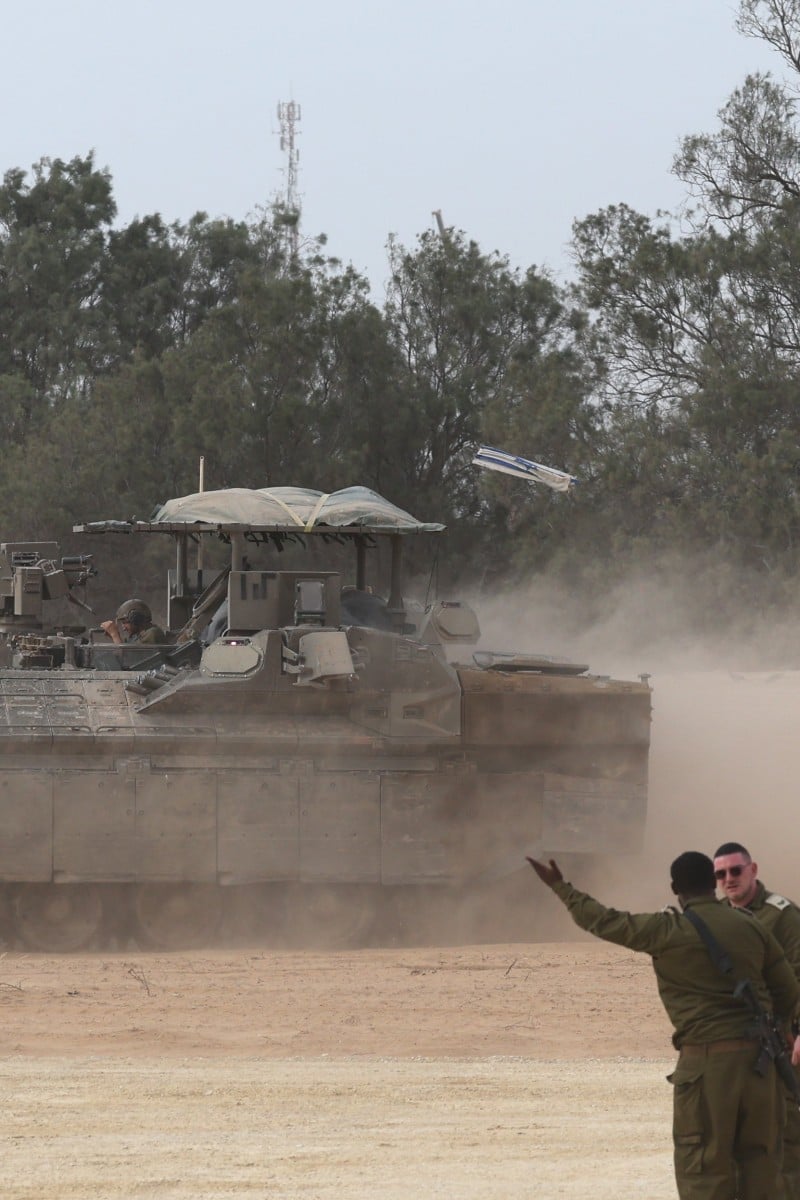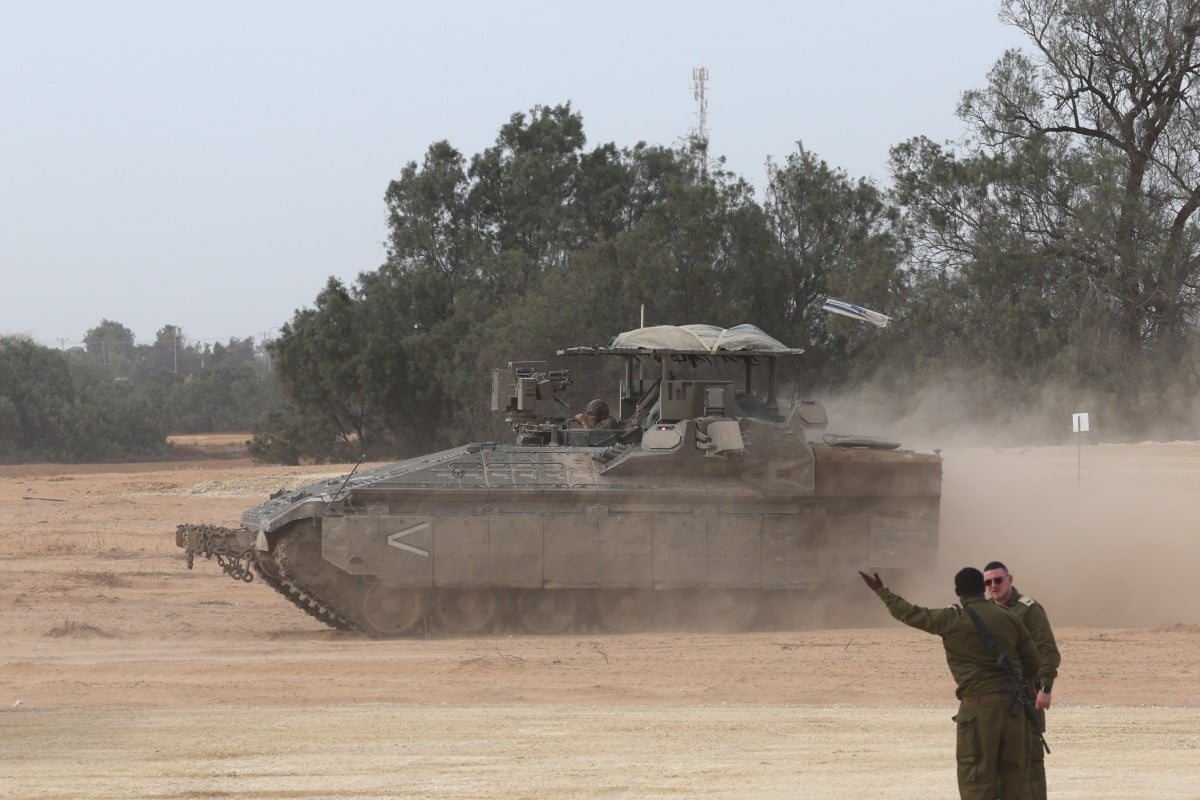
Your Voice: How the Israel-Gaza war is portrayed in the media; flying cars are coming soon (long letters)
- One student writes that the way media depicts a conflict impacts the way society perceives it, citing examples of Palestinian hardship during the war
- Another student says flying cars will transform the way we commute, but with some drawbacks
 Media plays a pivotal role in influencing society in times of war and conflict, one student writes. Photo: EPA-EFE
Media plays a pivotal role in influencing society in times of war and conflict, one student writes. Photo: EPA-EFEHave something to say? Send us a letter using this Google form.
Role of mainstream media in war
Matthew Ng Cheuk-hin, St Stephen’s College
A photo taken in 2015 by Reuters photographer Mohamad Torokman shows a woman wearing a hijab shouting at a soldier. The soldier is holding a weapon and wearing a badge with the Israeli flag on his arm while a Palestinian flag waves in the background.
What do you see in this picture: a mighty soldier confronting a terrorist or a brave woman standing up against injustice?
If you choose the latter, then we are in agreement.
The photo is of a Palestinian woman shouting at an Israeli border police officer during a protest against Jewish settlements in the Occupied West Bank.
However, we do not see the current conflict in such a perspective from mainstream media.
Often, when Israel suffers casualties, news outlets flash headlines with words like “massacre” or “murder”. On the other hand, Palestinian deaths are simply called “losses”.
Journalists dying in Israel-Gaza war shows need to protect them
The choice of wording matters deeply, as it can have a significant impact on shaping public opinion. One single word has the ability to completely change a perspective and somebody else’s understanding of the issue. That is precisely the problem we are facing currently.
Prominent news organisations like CNN and Fox News often paint this one-sided narrative where Israel is the victim protecting itself, and Palestine is the aggressor and the big bad wolf in this war.
One common trope that pro-Israel supporters use is that Israel is the victim defending its sovereignty against terrorism.
This narrative tends to focus on the security challenges Israel faces. By emphasising these threats, Israel’s actions are often portrayed as a justified response to protect its citizens.
In contrast, the experiences and hardships of Palestinians living under tear gas and occupation are often downplayed and ignored in mainstream media.
The focus on Israel’s security concerns has overshadowed the daily hardships of Palestinians, like home demolitions, land confiscation, settler violence and restricted movements.
“Murder” or “defence”? In complicated situations like this, the choice of language should be fair, accurate and nuanced. It is crucial that both sides of the story are heard and that the experiences and perspectives of all those affected are given proper attention. Without cooperation, peace will never be able to prevail.
Flying cars: assessing the pros and cons
Heer Donda, King George V School
The evolution of cars goes all the way back to 1896, when the first vehicle powered by a gas engine was made. The shapes, efficiencies and abilities of cars have developed over time, but the idea of flying cars has always seemed like a faraway fantasy. However, technological advancements have steadily brought us closer, and the arrival of flying cars feels closer than ever.
Alef Aeronautics, an automotive company in the United States, has been working since 2015 to develop a flying car. They envision their products as vehicles for personal use, unlike air taxis being developed by another company, Joby’s Aviation. Last year, Alef got permission from the Federal Aviation Administration (FAA) to test their vehicles on land and in the sky. They claim they can begin production near the end of 2025.
From Germany’s Volocopter to China’s EHang, many companies are testing these mini-aircraft. The Japanese government has taken a considerable step towards flying vehicles by agreeing to develop take-off and landing infrastructure. They are also working towards the concept of flying taxis, aiming to bring them to life in 2025.
Nonetheless, it is crucial to examine the advantages and disadvantages of this product for society.
Traditional cars are one of the leading causes of global warming. When diesel and petrol are combusted, the by-products that form are harmful to our health and contain greenhouse gases which harm the environment.
Rules needed if Japan wants air taxis to take off
An article by Nature Communications showcases that flying cars are more energy-efficient for longer trips. Despite needing more energy during take-off and landing, flying cars are found to have lower emissions for trips beyond 35km. This is because they are more energy efficient during the cruise flight; making them a more sustainable alternative for any kind of long-distance travel.
Another advantage is a lesser need for ground infrastructure. With flying cars, we can save more space on the ground for facilities such as healthcare and education.
Various drawbacks may also ask us to reconsider this advancement.
For example, huge production costs would lead to a high selling price. Not everyone will be able to drive, so a paid flying lesson or paid pilot is a necessity. This is fairly problematic as a sustainable lifestyle should be affordable to everyone.
Another inconvenience is the need to adjust infrastructure or runways to allow for the safe take-off and landing of this new aircraft.
Lastly, flying cars require more energy for safe take-offs, landings and flights. While long-distance flights would be more energy efficient, a shorter distance requires greater energy in comparison to the time between take-off and landing.
‘Iron Man’ pilots compete in Dubai’s first-ever jet suit race
This increased use of energy would most likely create noise pollution that could be disruptive to the community.
In spite of these disadvantages, this approach has benefits that will take the world a step ahead. Flying cars can decrease petrol car usage. The advances in vertical take-off and landing aircraft (VTOLs) will also lead to exciting advantages for society.
